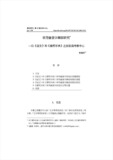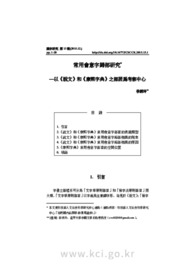

PARTNER
검증된 파트너 제휴사 자료
常用會意字歸部研究 —以《說文》和《康熙字典》之部居爲考察中心
방대한 850만건의 자료 중 주제별로 만들수 있는 최적의 산출물을 해피 캠퍼스에서 체험 하세요 전문가의 지식과 인사이트를 활용하여 쉽고 폭넓게 이해하고 적용할수 있는 기회를 놓치지 마세요
20 페이지
최초등록일 2016.04.02
최종저작일
2015.12

-
 * 본 문서는 배포용으로 복사 및 편집이 불가합니다.
* 본 문서는 배포용으로 복사 및 편집이 불가합니다.
미리보기
서지정보
· 발행기관 : 경성대학교 한국한자연구소
· 수록지 정보 : 漢字硏究 / 13권
· 저자명 : 李綉玲
목차
1. 引言
2.《說文》和《康熙字典》常用會意字部首的表義類型
3.《說文》和《康熙字典》常用會意字歸部相異的現象
4.《說文》和《康熙字典》常用會意字歸部相異的原因
5.《康熙字典》常用會意字部首的空間位置
6. 結語영어초록
Compound ideographs (會意, Hui Yi) are formed by two or more phonetic or semantic parts. But when both parts are radicals, how should we classify the character? This issue involves not just identification of the syntax, but also the context. In other words, the issues lies in how the radical of a compound ideograph signifies the meaning of the character through the logic of the radical and what role the radical plays in the overall definition of the character. This has been a puzzling issue to many and calls for in-depth exploration. Classification of Chinese character radicals can be divided into two major systems; philology principles and dictionary reference principles. The former is mainly based on the meaning and supplemented by the form. This radical system emerged from the Shuowen Jiezi (說文解字), emphasizing the relationship between the radical and the subordinate part in terms of the structure and semantics. The latter is mainly based on the form and supplemented by meaning. This system emerged from Wujing Wenzi. The “Li Bu (立部)” and “Gui Bu (歸部)” classification system used in the Kangxi Dictionary, on the other hand, follows the principle, “Easy to reference with logical grouping of semantics without contradicting the intended meaning given by the creator.” This principle was an attempt to integrate the systems of philology principle-based and dictionary reference principle-based radical systems. Based on the above, this research studies the “Gui Bu” classification of compound ideographs, focusing on the “frequently-used characters” published by the Ministry of Education, with an attempt to clarify the issues relating to the “Gui Bu” classification of the commonly-used compound ideographs in the Shuowen Jiezi and Kangxi Dictionary.참고자료
· 없음태그
-
자료후기
Ai 리뷰지식판매자의 자료는 항상 최신 정보를 반영하고 있어 믿을 수 있습니다. 특히, 각 주제에 대한 깊이 있는 분석과 명확한 설명 덕분에 복잡한 개념도 쉽게 이해할 수 있었습니다. 여러분에게도 강력히 추천합니다! -
자주묻는질문의 답변을 확인해 주세요

꼭 알아주세요
-
본 학술논문은 (주)코리아스칼라와 각 학회간에 저작권계약이 체결된 것으로 AgentSoft가 제공 하고 있습니다.
본 저작물을 불법적으로 이용시는 법적인 제재가 가해질 수 있습니다. -
해피캠퍼스는 구매자와 판매자 모두가 만족하는 서비스가 되도록 노력하고 있으며, 아래의 4가지 자료환불 조건을 꼭 확인해주시기 바랍니다.
파일오류 중복자료 저작권 없음 설명과 실제 내용 불일치 파일의 다운로드가 제대로 되지 않거나 파일형식에 맞는 프로그램으로 정상 작동하지 않는 경우 다른 자료와 70% 이상 내용이 일치하는 경우 (중복임을 확인할 수 있는 근거 필요함) 인터넷의 다른 사이트, 연구기관, 학교, 서적 등의 자료를 도용한 경우 자료의 설명과 실제 자료의 내용이 일치하지 않는 경우
찾으시던 자료가 아닌가요?
지금 보는 자료와 연관되어 있어요!
문서 초안을 생성해주는 EasyAI


